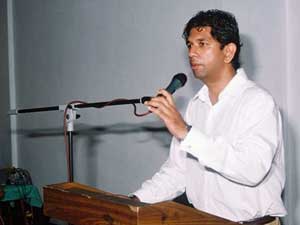|
10.08.09 - NF -
Sri Lanka: Dave Maurice presents the Nucleus Approach as instrument for SME
promotion at the LED conference in Colombo
Nucleus: Using a group SME
promotion approach to achieve Local Economic Development
 The Nucleus
Approach was presented by Dave Maurice (Director of the Nucleus Foundation) at
the recently concluded LED conference in Colombo. The gist of the
presentation - incorporated into three power point slides - was that through
the Nucleus Approach entrepreneurs
in working groups share problems, ideas and experiences,
support learning networks within sectors, undertake activities to
upgrade their enterprises and / or influence framework conditions,
foster inter regional and inter ethnic business linkages, thereby
contributing the local economic development. Nucleus also helps to
identify competitive sectors and analyse value chains mobilising
entrepreneurs across different stages of the value chain to address gaps
and exploit opportunities. The positive feedback to the presentation
indicates that conference participants recognised the Nucleus Approach as a practical
tool for developing local economies. The Nucleus
Approach was presented by Dave Maurice (Director of the Nucleus Foundation) at
the recently concluded LED conference in Colombo. The gist of the
presentation - incorporated into three power point slides - was that through
the Nucleus Approach entrepreneurs
in working groups share problems, ideas and experiences,
support learning networks within sectors, undertake activities to
upgrade their enterprises and / or influence framework conditions,
foster inter regional and inter ethnic business linkages, thereby
contributing the local economic development. Nucleus also helps to
identify competitive sectors and analyse value chains mobilising
entrepreneurs across different stages of the value chain to address gaps
and exploit opportunities. The positive feedback to the presentation
indicates that conference participants recognised the Nucleus Approach as a practical
tool for developing local economies.
One of the questions that was asked
was how to ensure the sustainability of the approach for example when
it’s used to compliment value chain interventions. In response Dave
said:
When it comes to any kind of
entrepreneurship or livelihood development intervention, to make it
succeed you require active participation from the entrepreneurs and
livelihood groups. When you mobilize such groups to share ideas and
experience and to undertake joint activities they are compelled to take
ownership of the intervention. For example when a group of cinnamon
producers invest in equipment for common they are compelled to make it
sustainable and to take ownership. They buy into the fact that by
undertaking this activity collectively they are sharing the cost thereby
reducing it for each person. Because they invest their own money they
are also required to make it work and to make profits for themselves.
This above all is what creates the sense of ownership leading to
sustainability. This is the reason the Nucleus approach has become a
popular SME and livelihood development approach in Sri Lanka.
Development projects come and go. If
we take an honest look at ourselves as development practitioners, how
many of us can say that we have contributed to something “sustainable”?
Nucleus was introduced to Sri Lanka more as a tool for organizational
development of chambers of commerce, SME promotion was secondary. Today
not a single of the over 10 chambers supported with subsidies and
technical assistance are implementing the approach in this country. But
Nucleus groups still function, not as part of a chamber and often
without a Nucleus Counselor (the counselor was seen as an integral part
of the approach organizing a facilitating the activities for the
groups). They still function as a group; leaders have emerged; and they
have taken ownership because they see the advantages of working
together. Some of the stronger groups have emerged as their own
organization, like the Sri Lanka Computer Vendors Association Central
Province, The Uva Region Printers Association, Kandyan Floral
Association. This is what makes the Nucleus Approach sustainable, the
ability to mobilize entrepreneurs and keep them interested in their own
development.
 Dave's Presentation (ppt)
Dave's Presentation (ppt) |